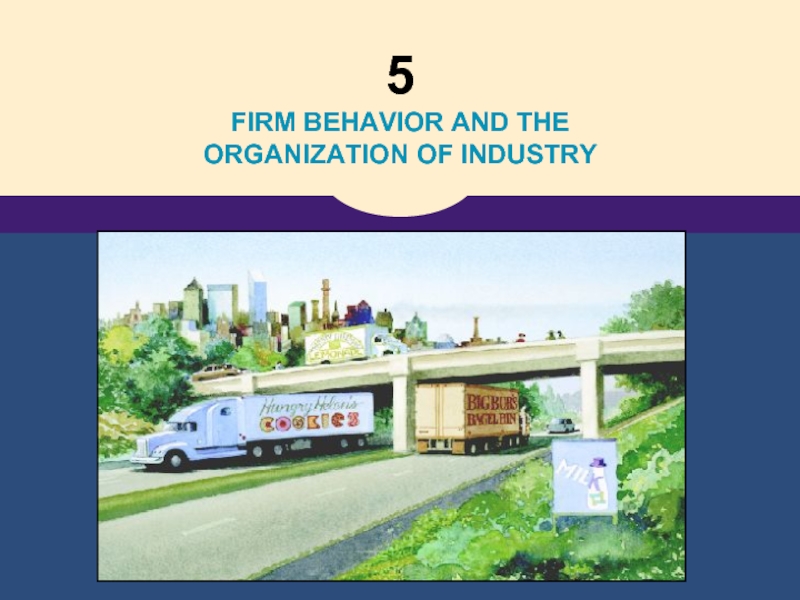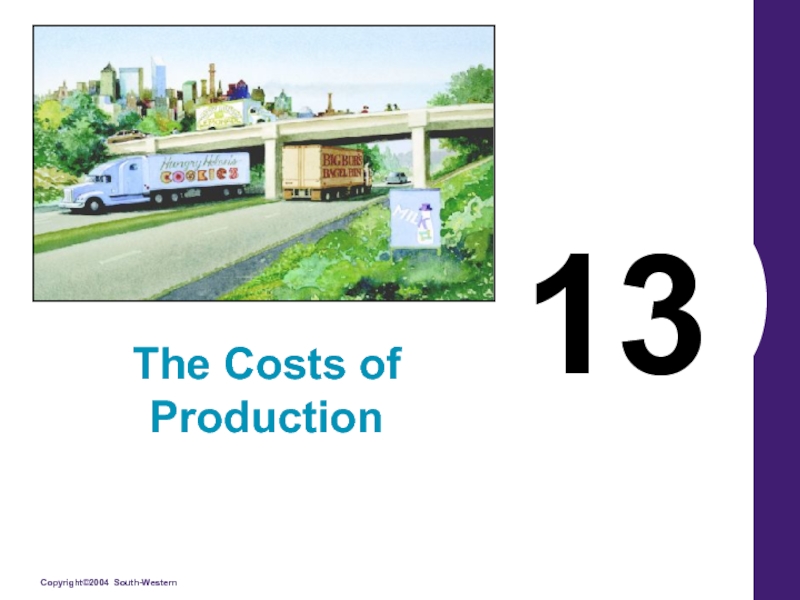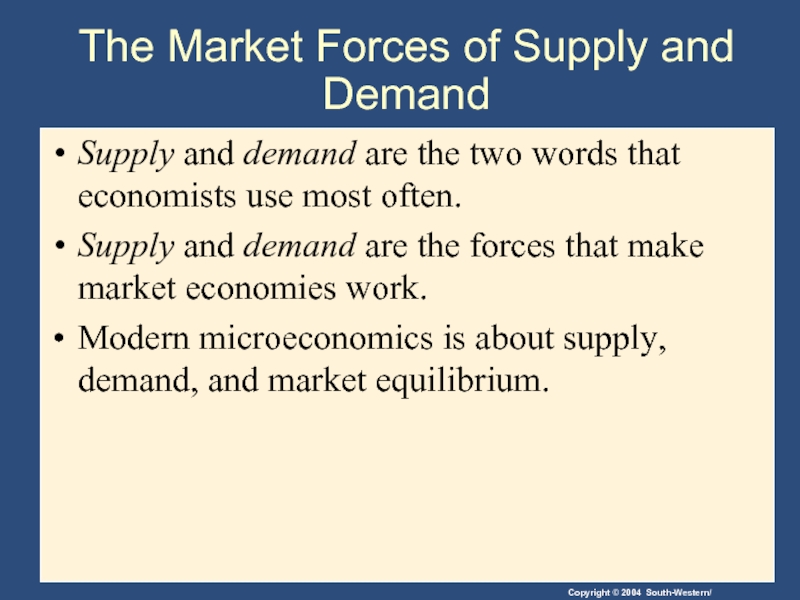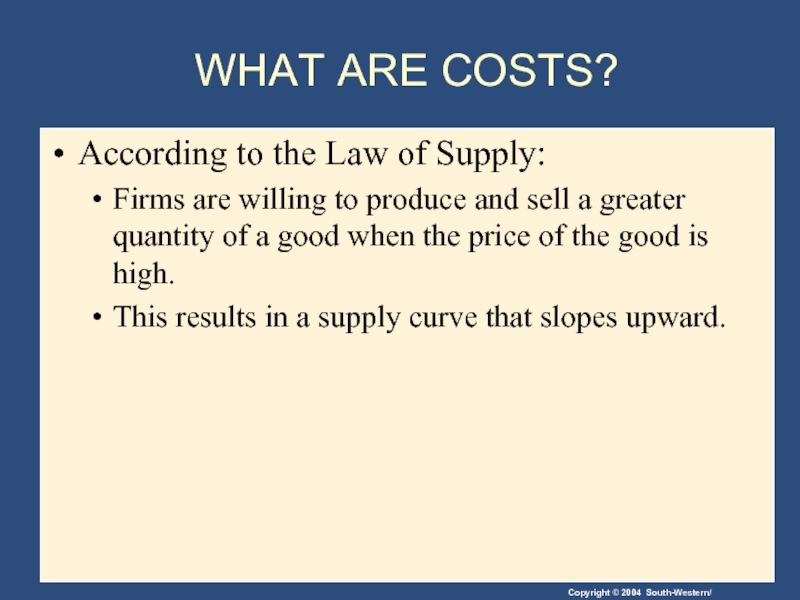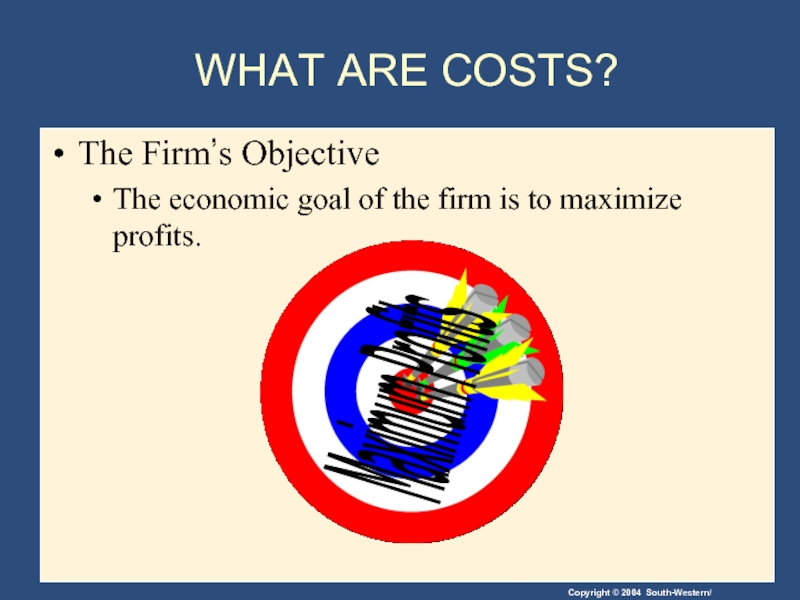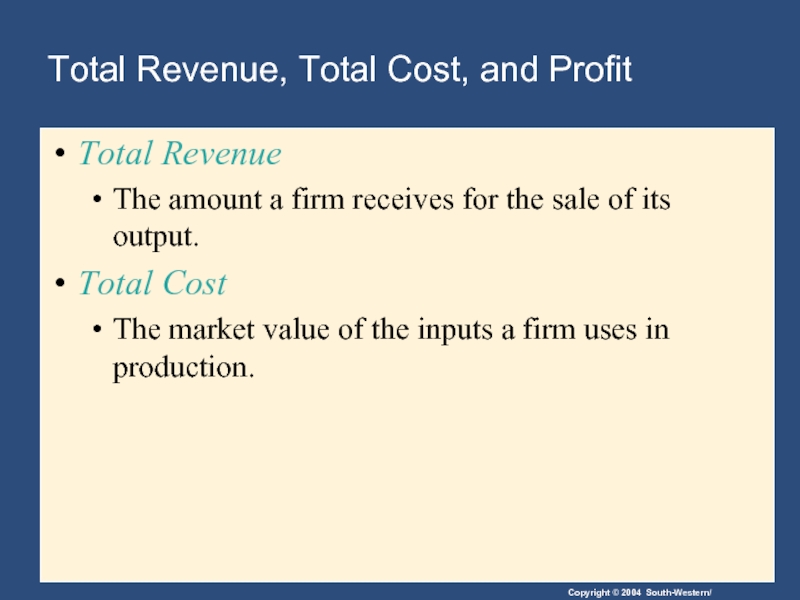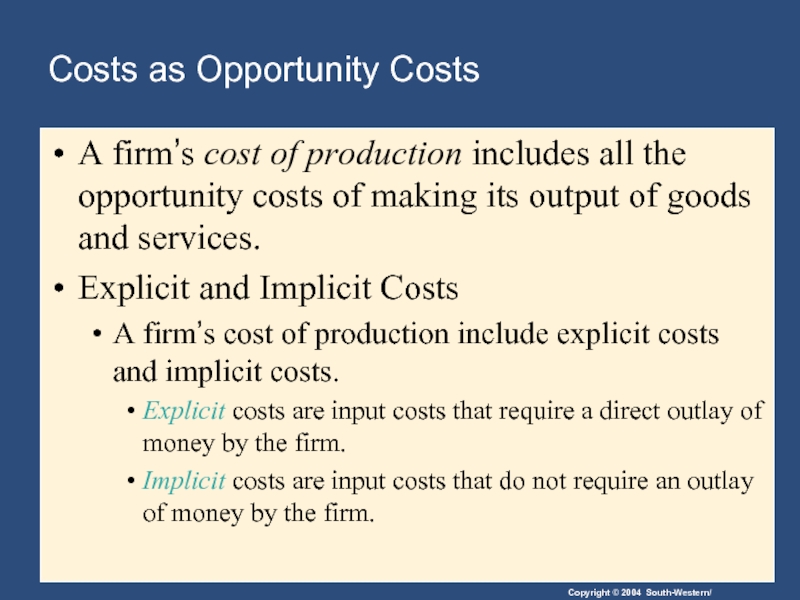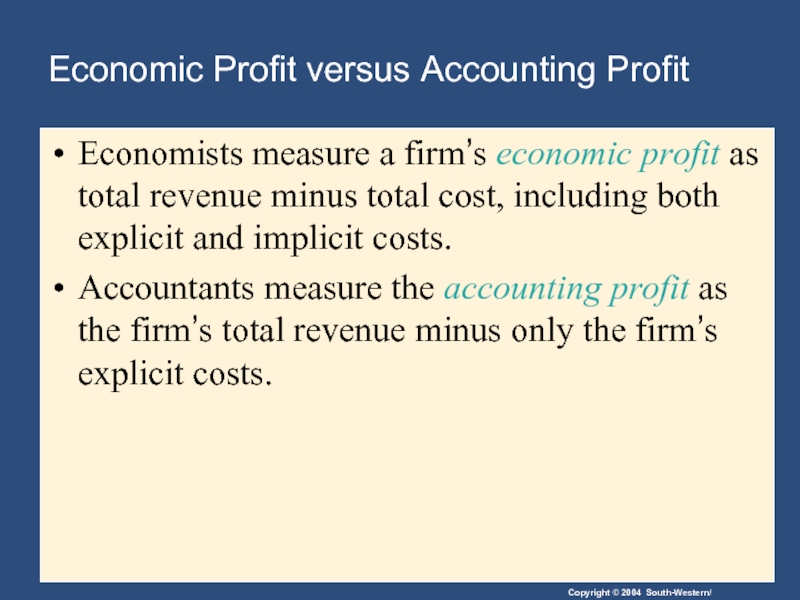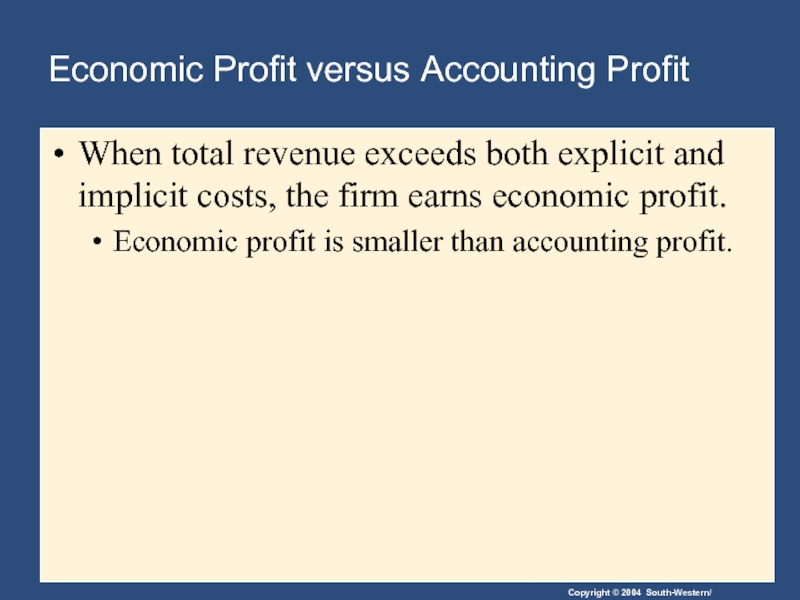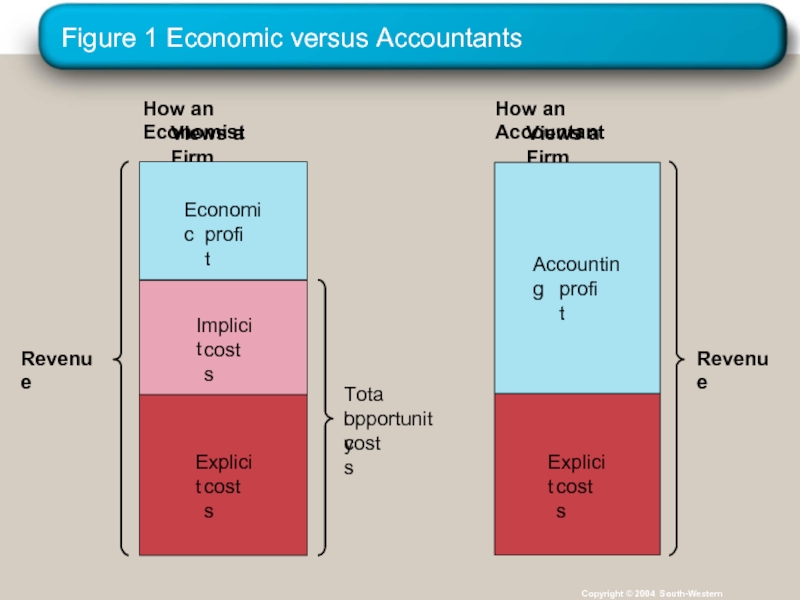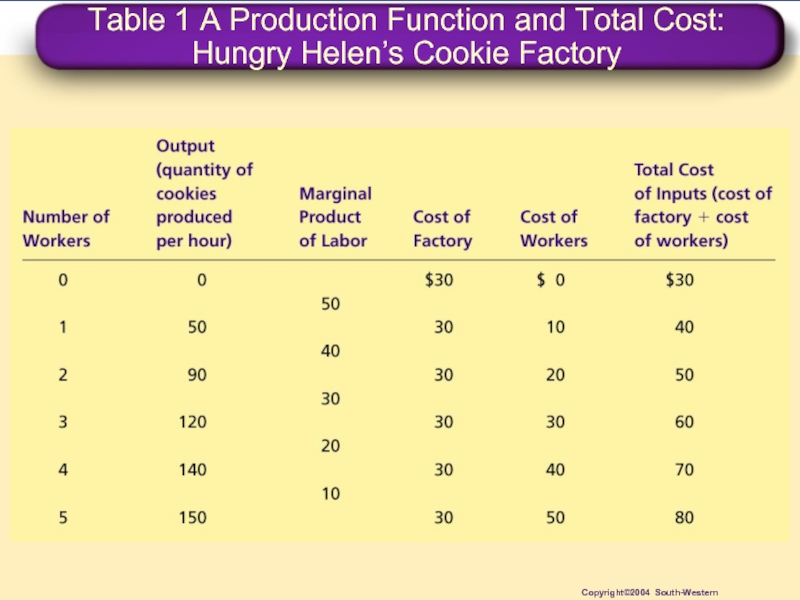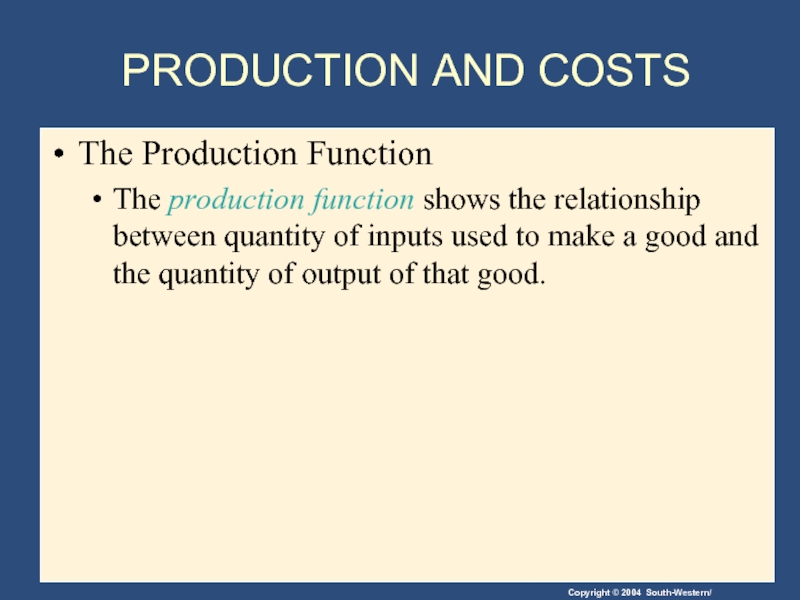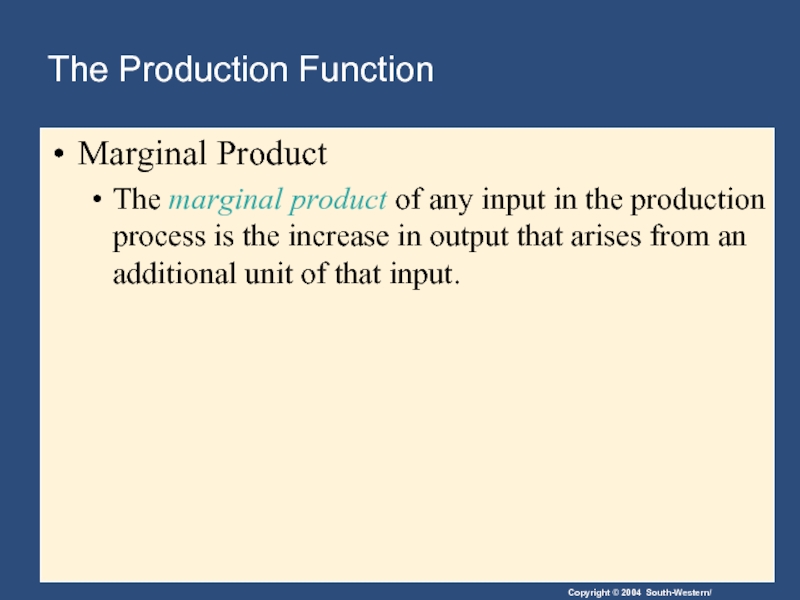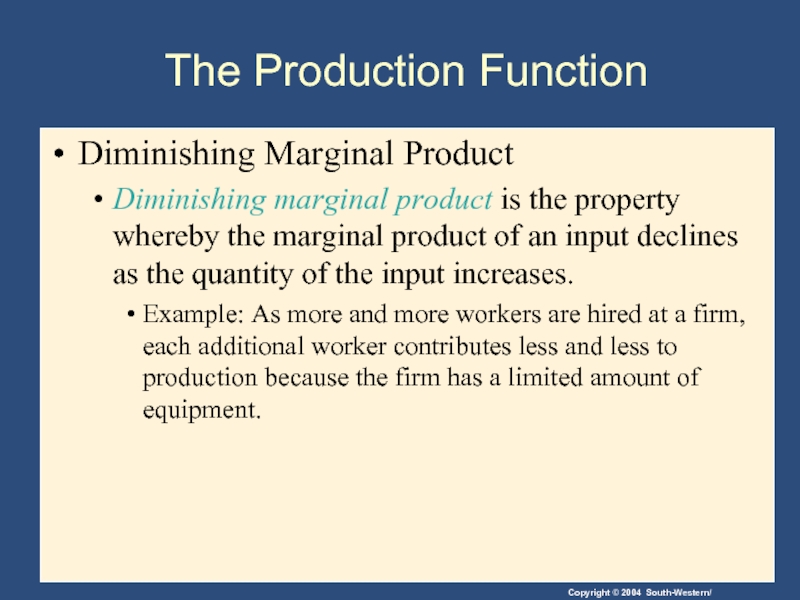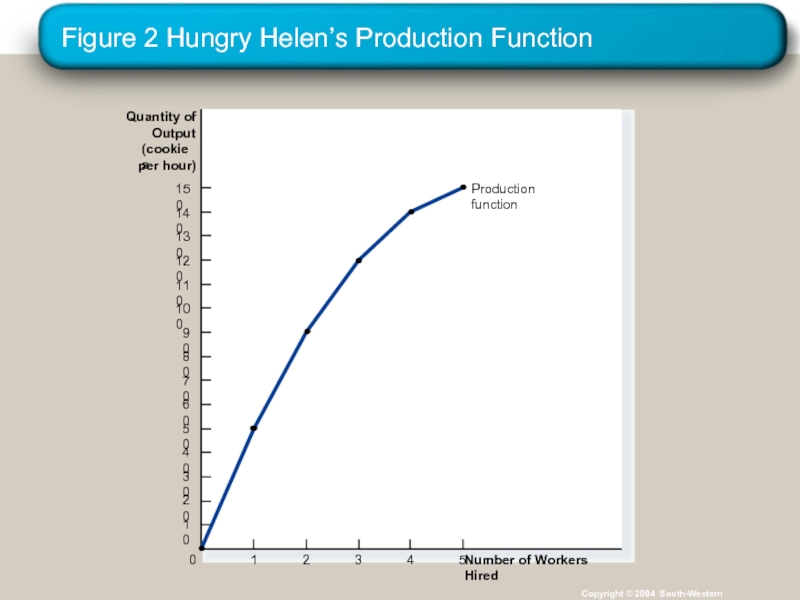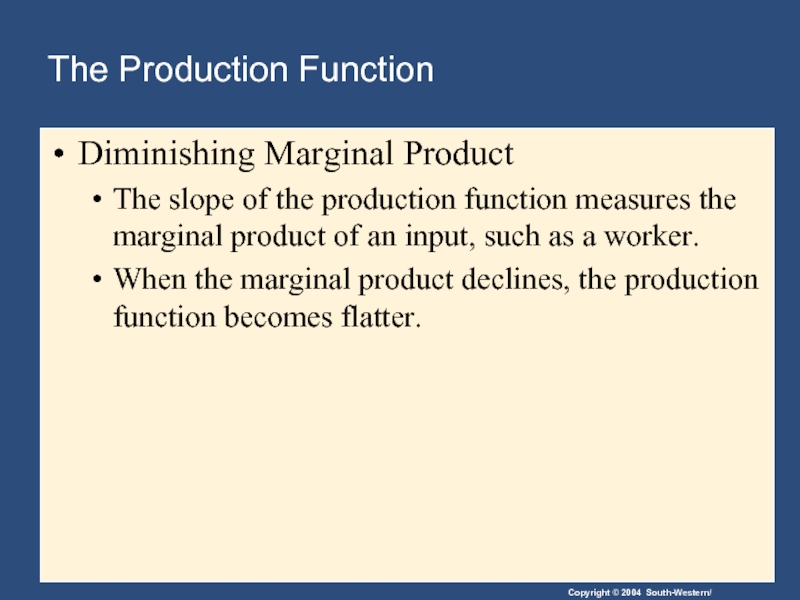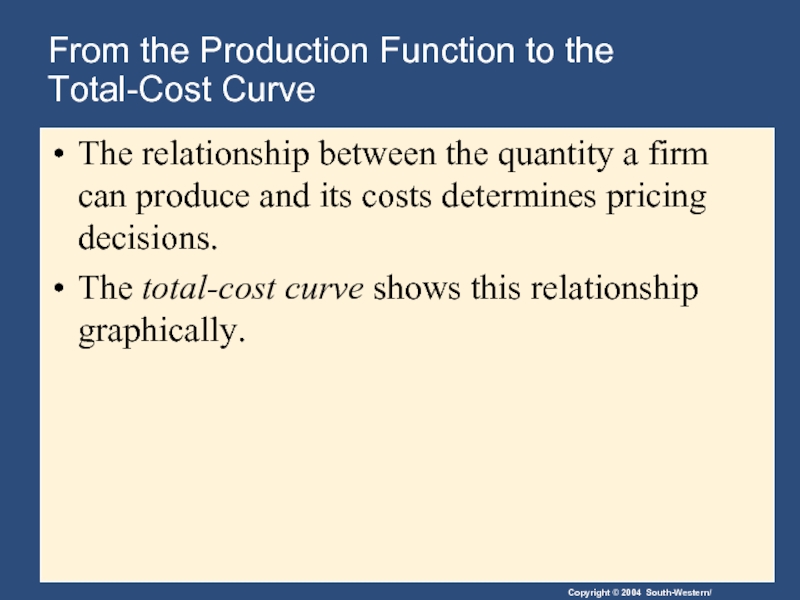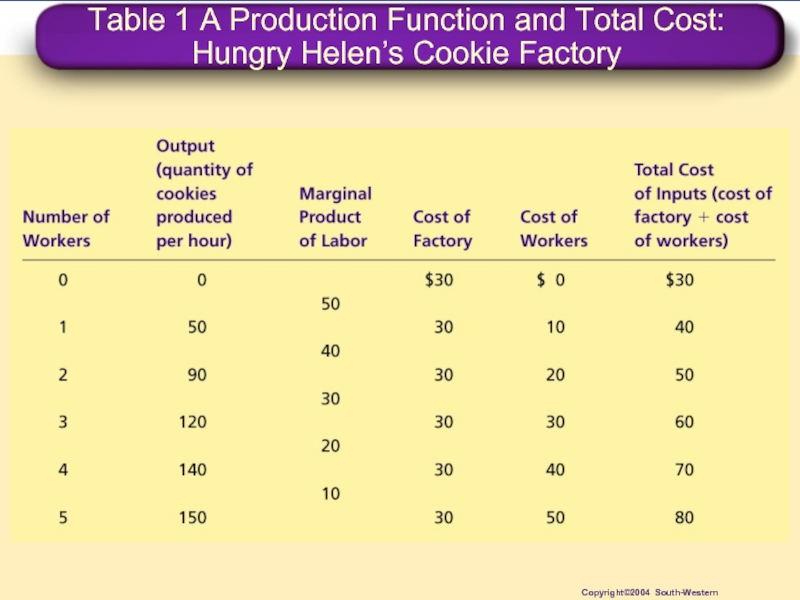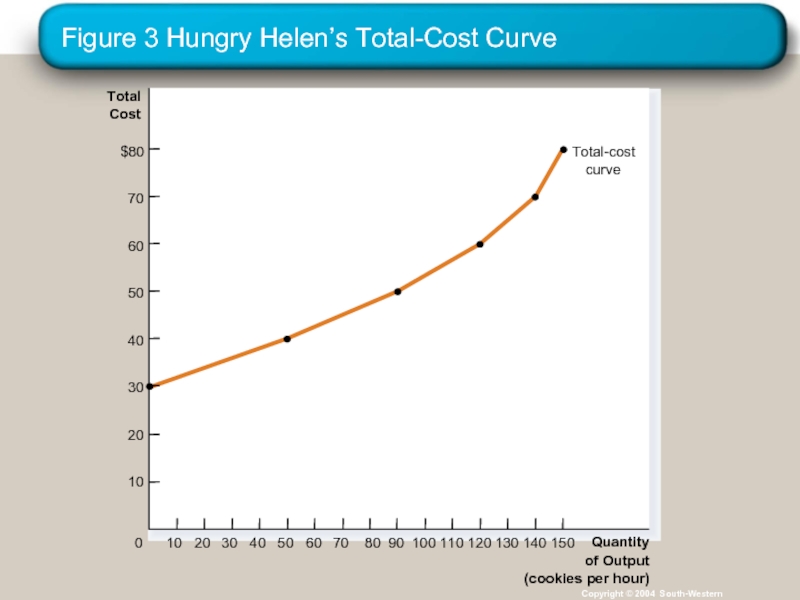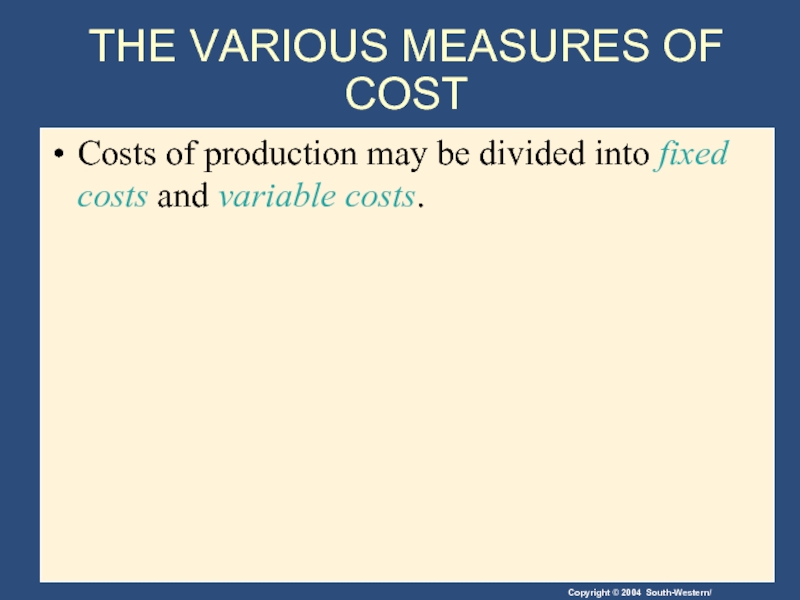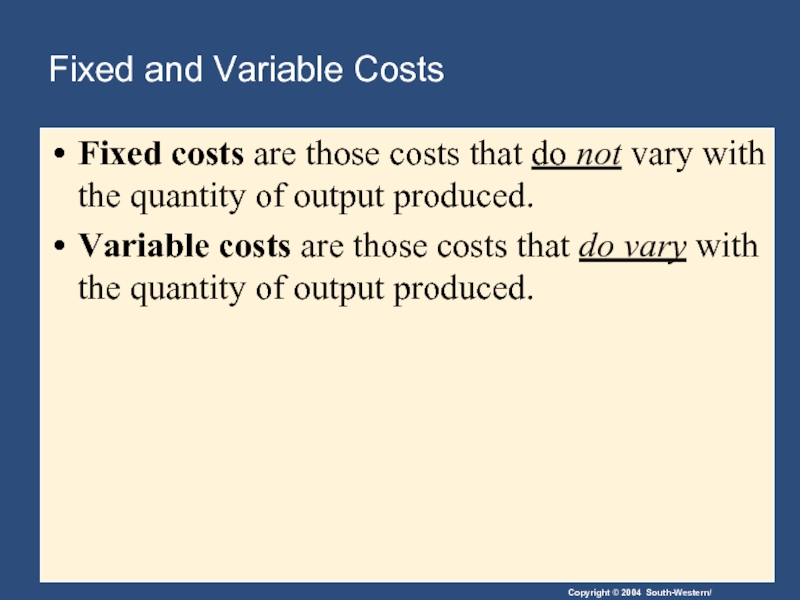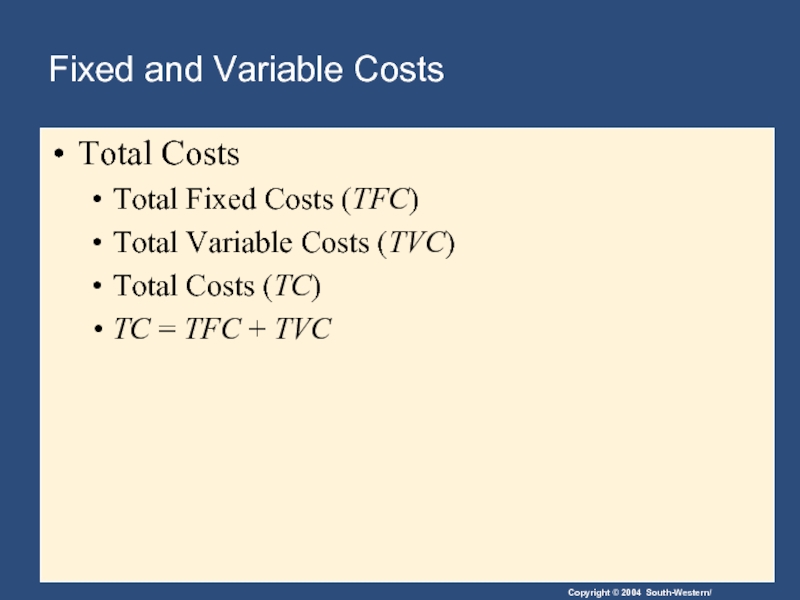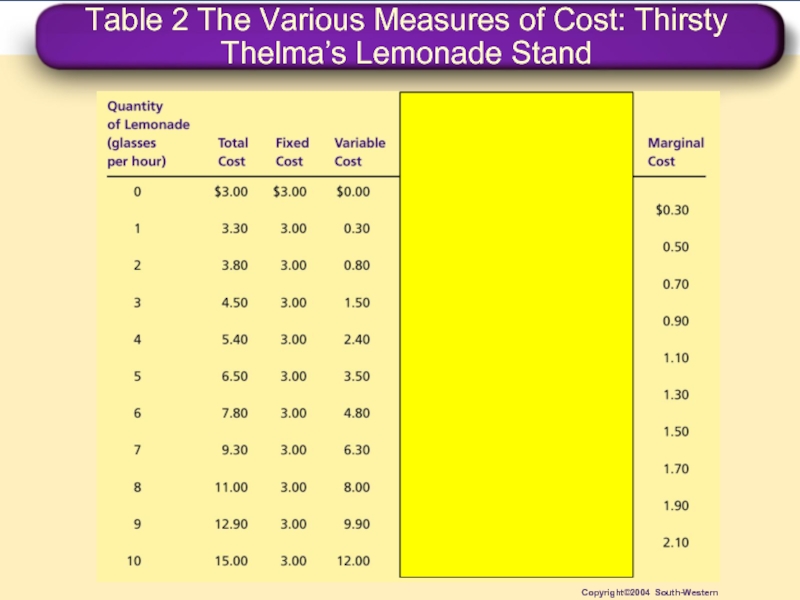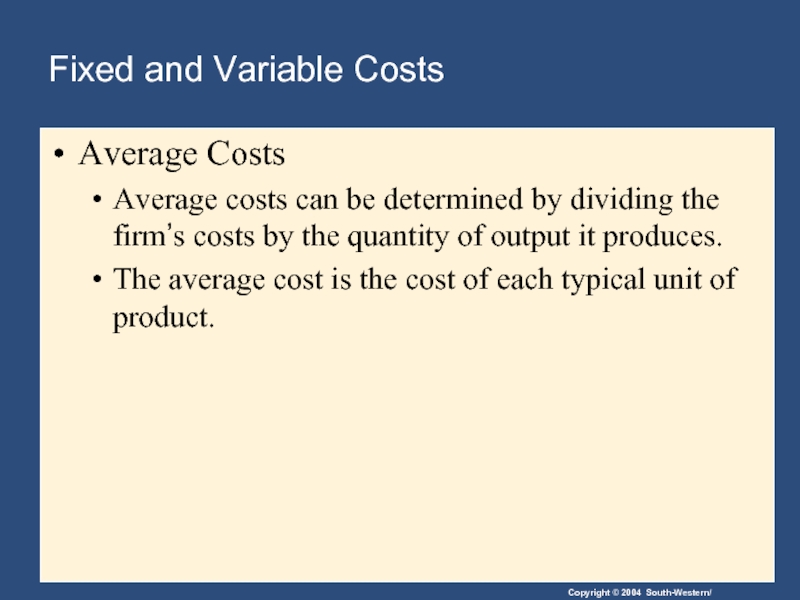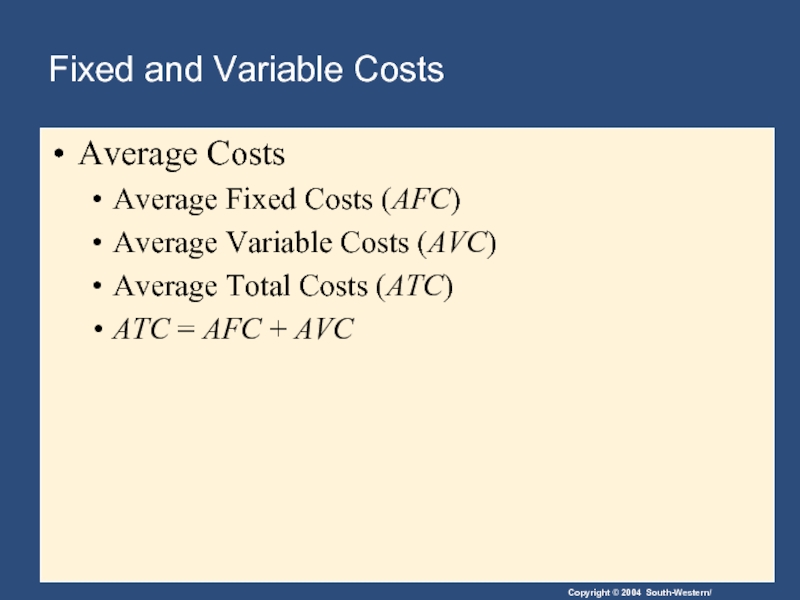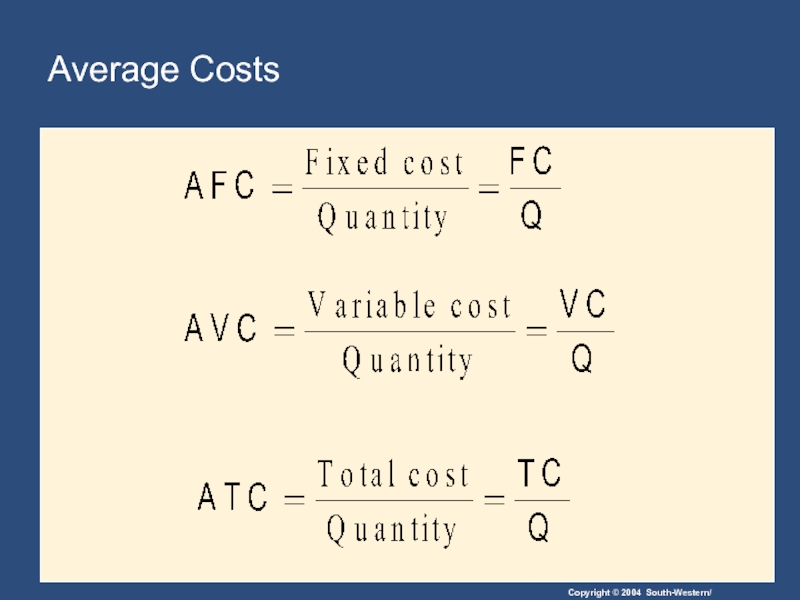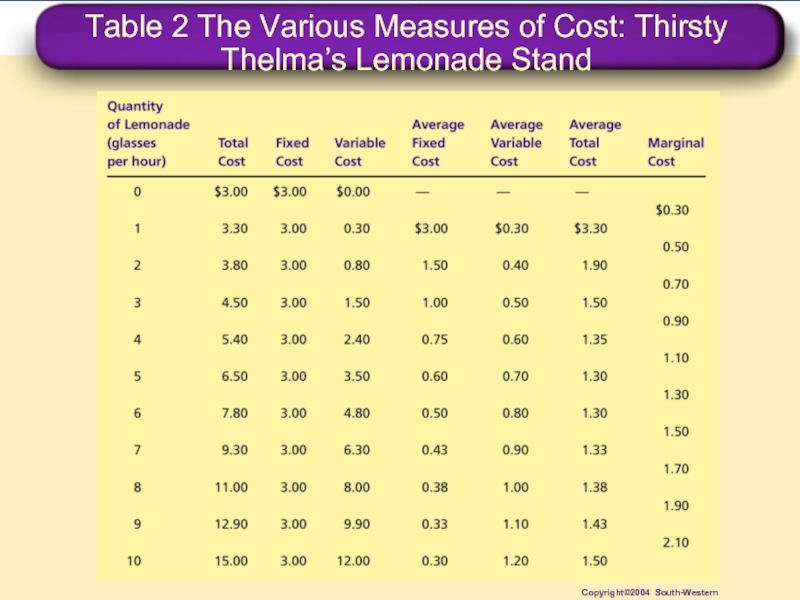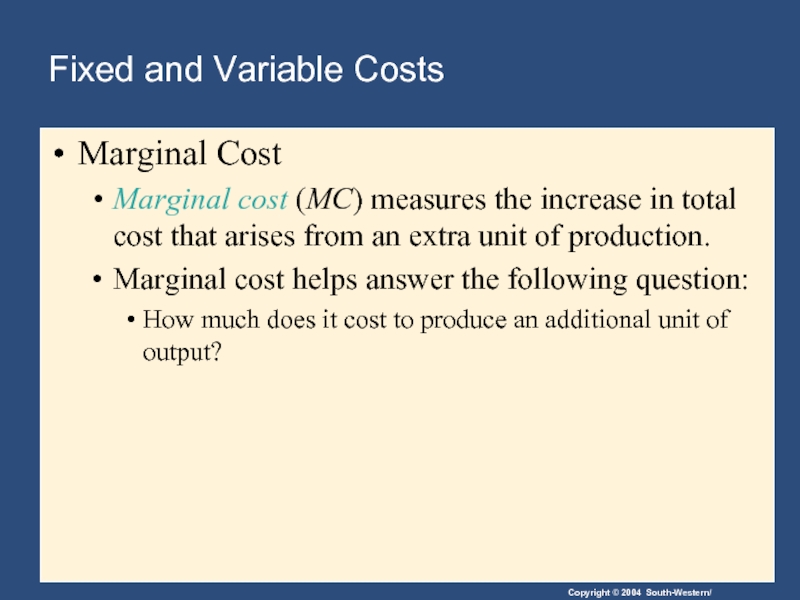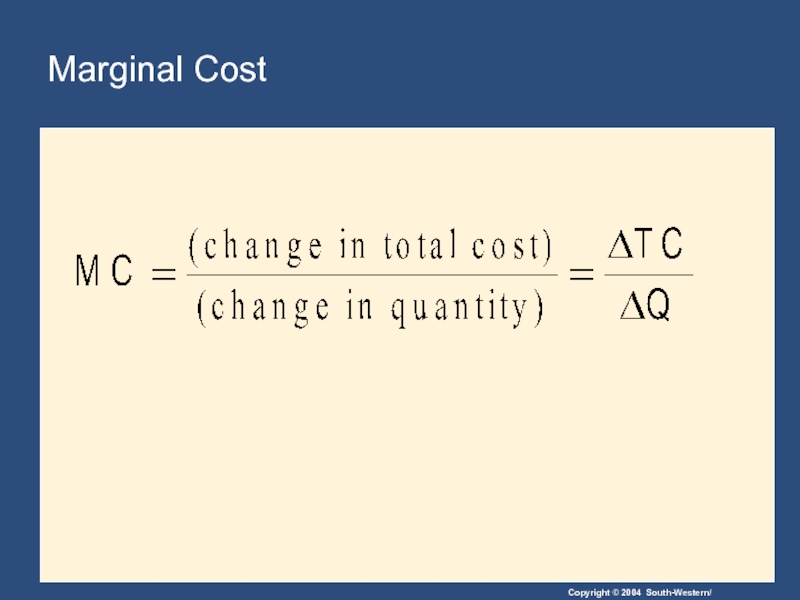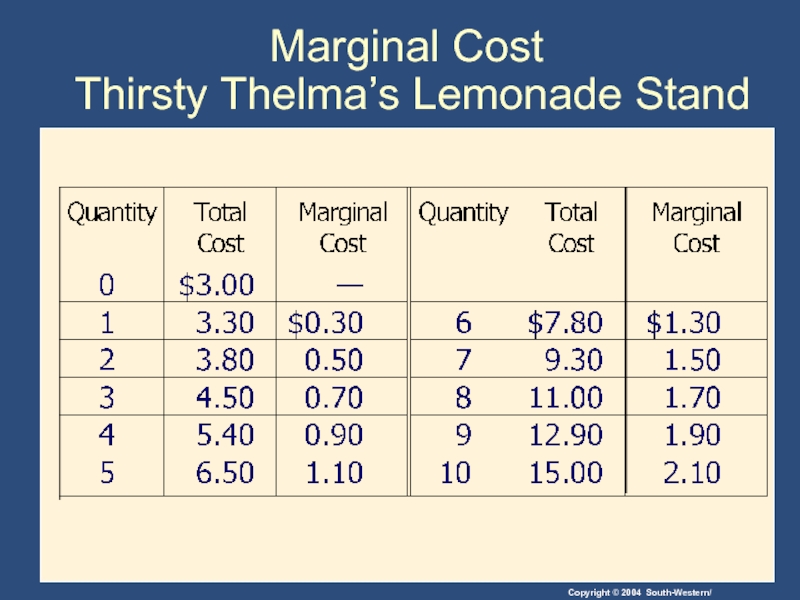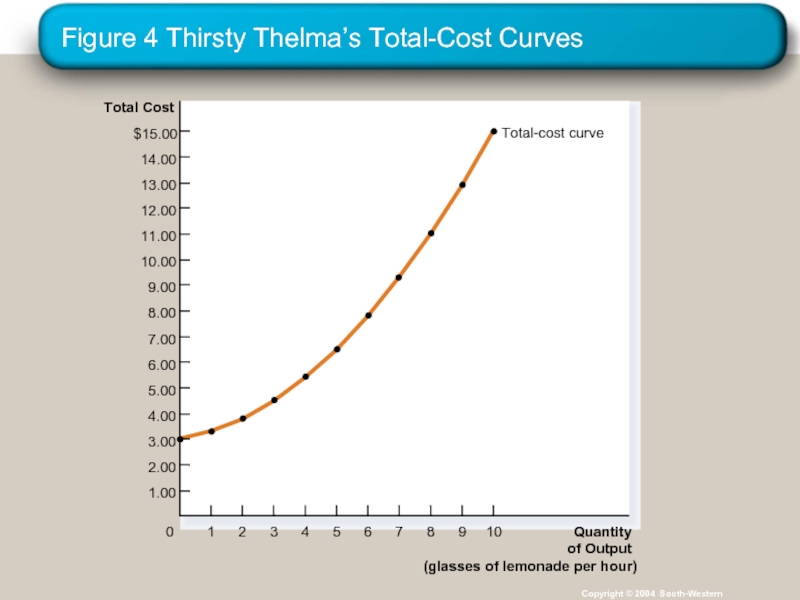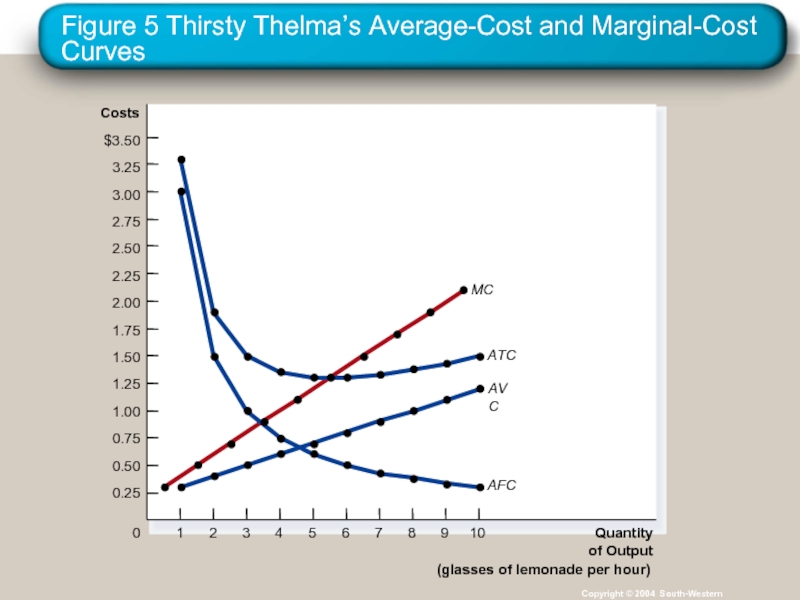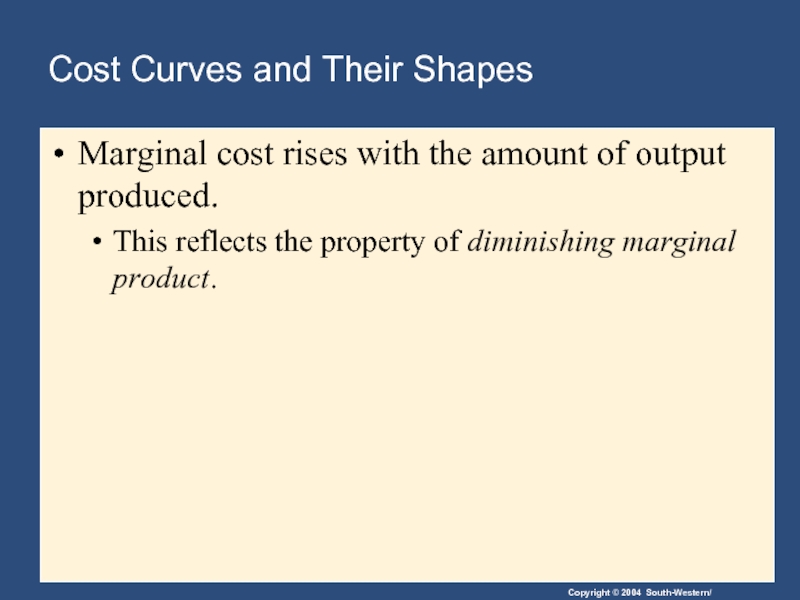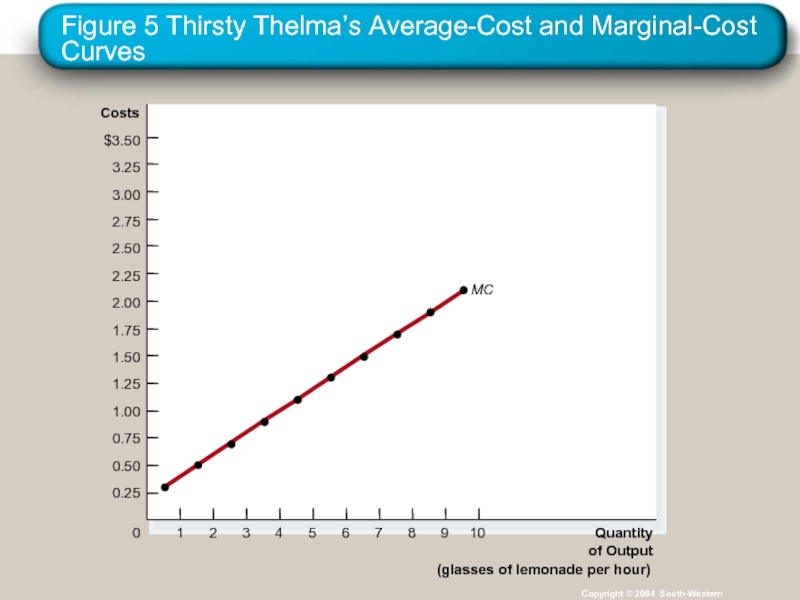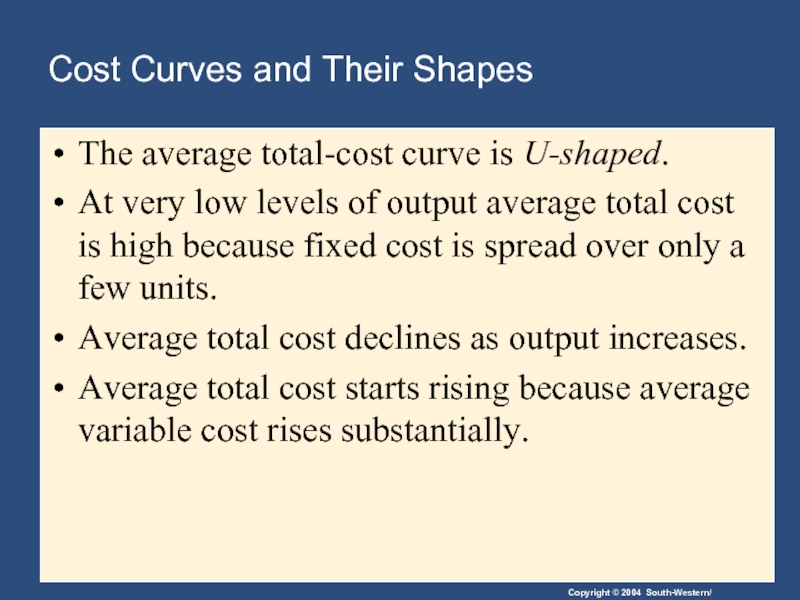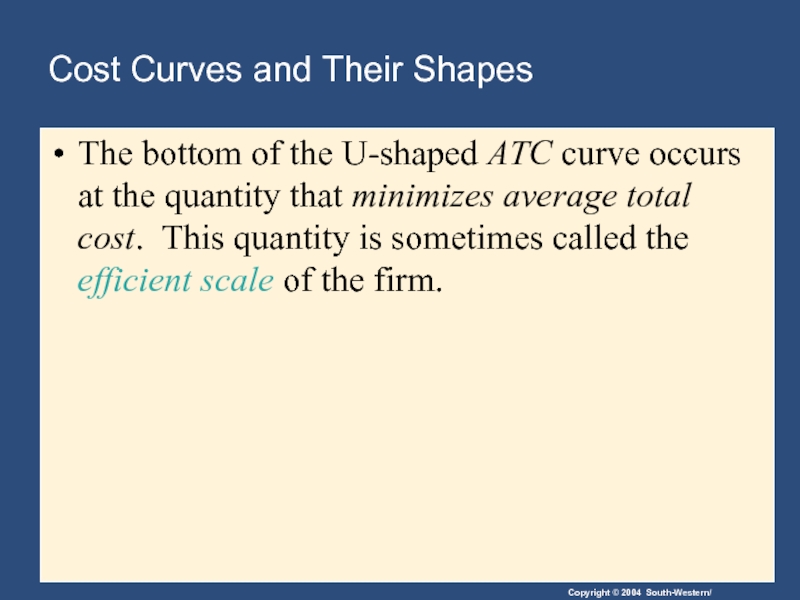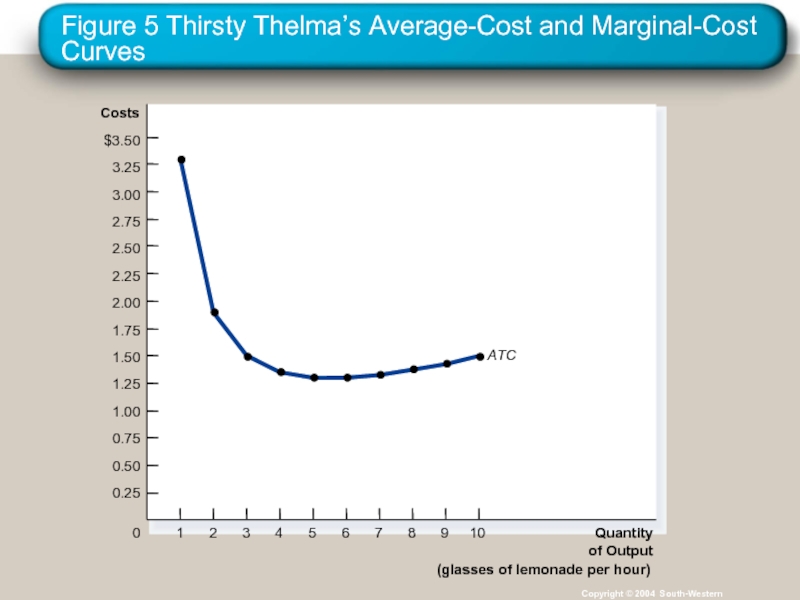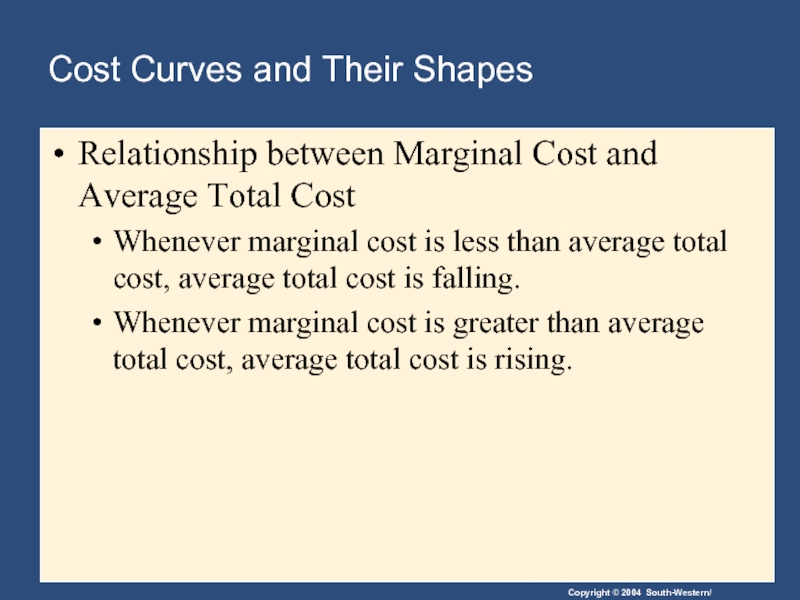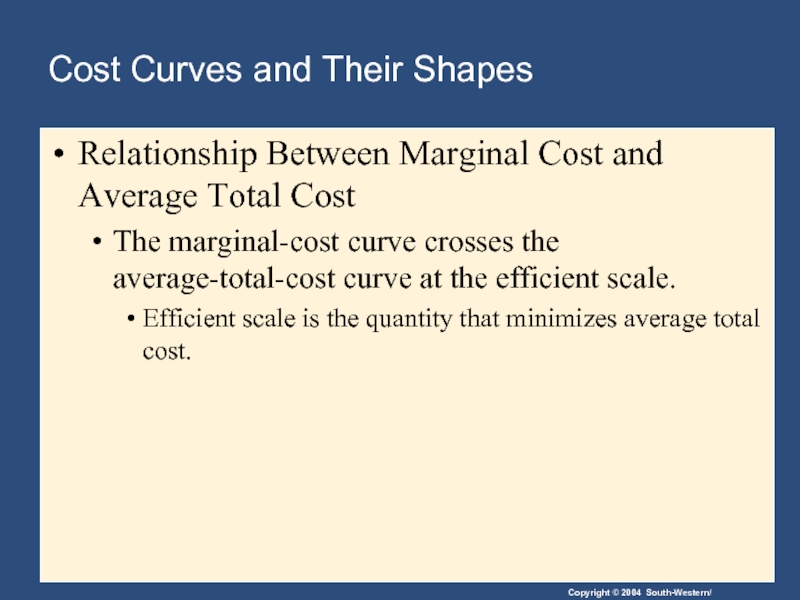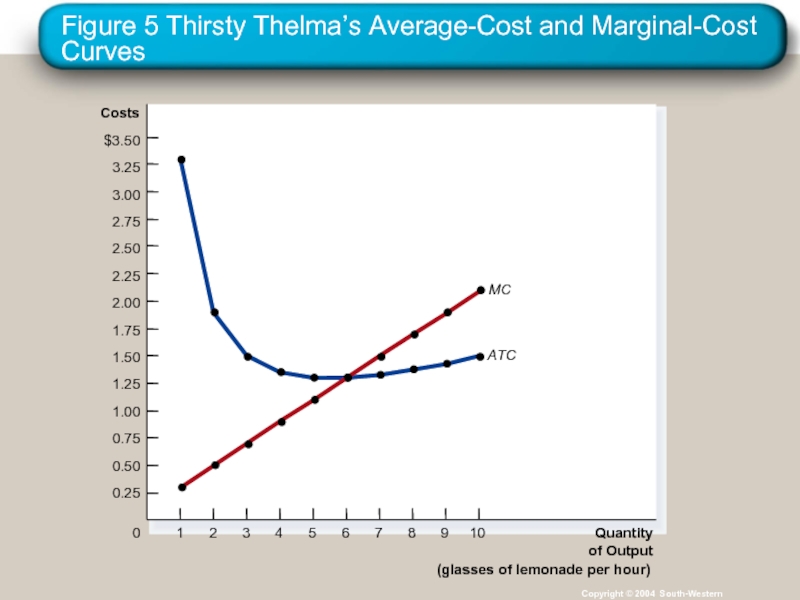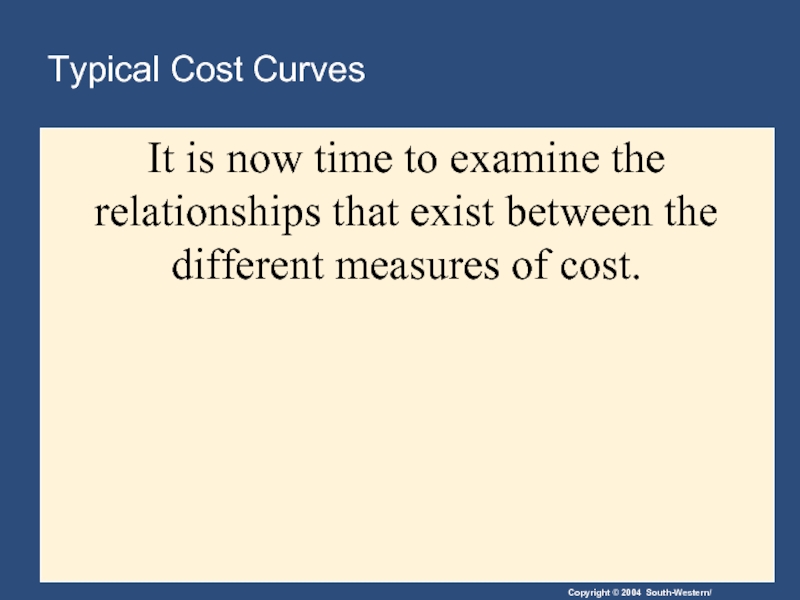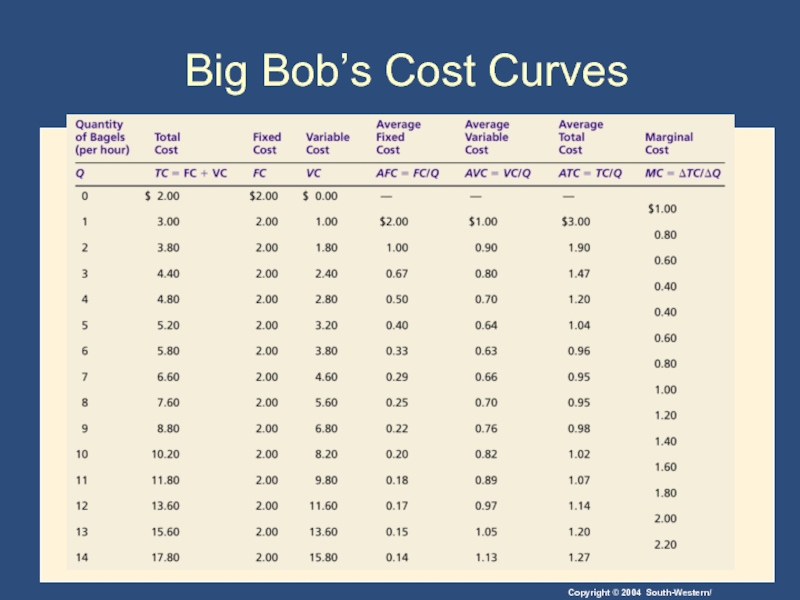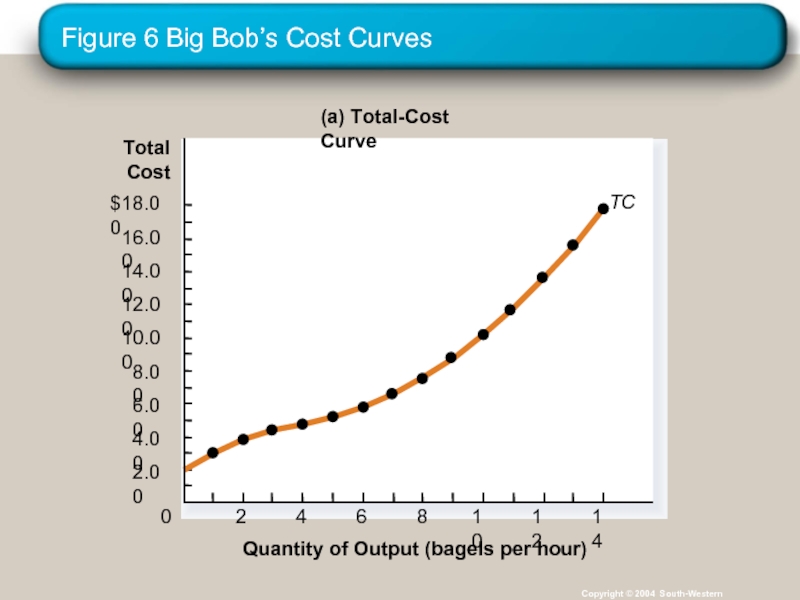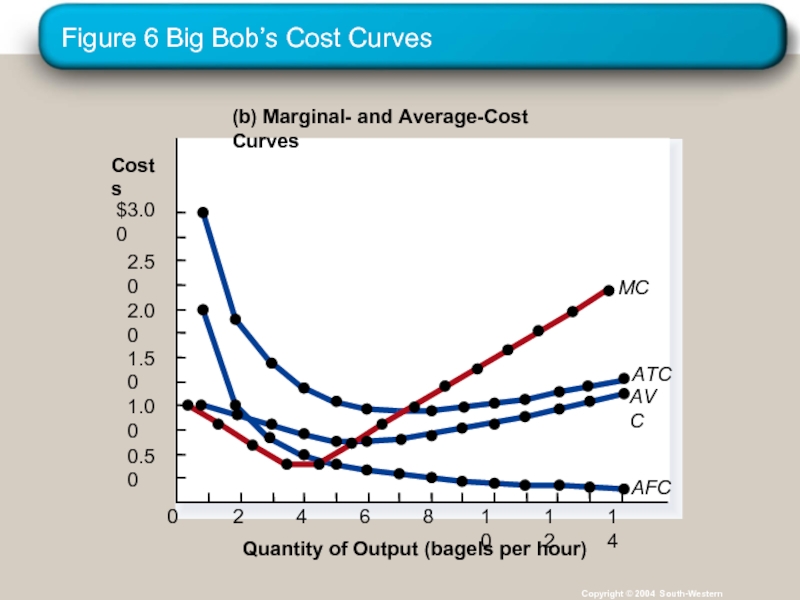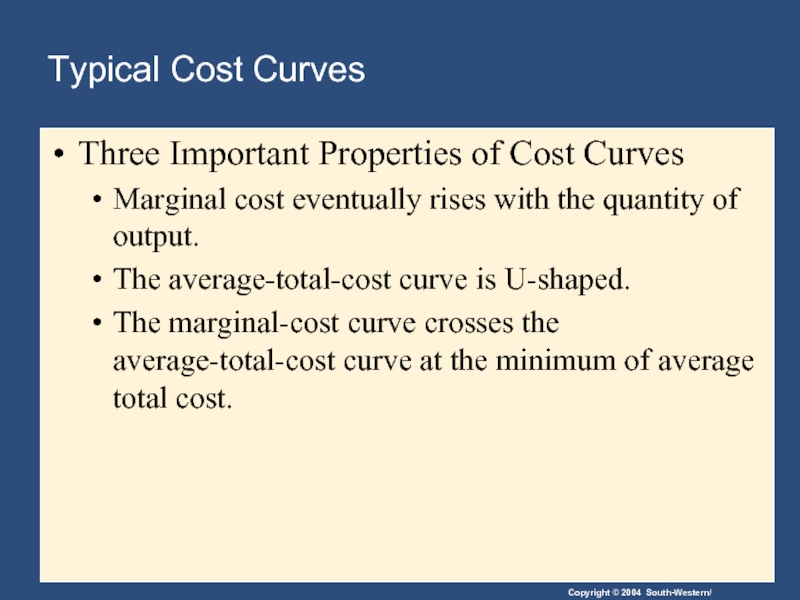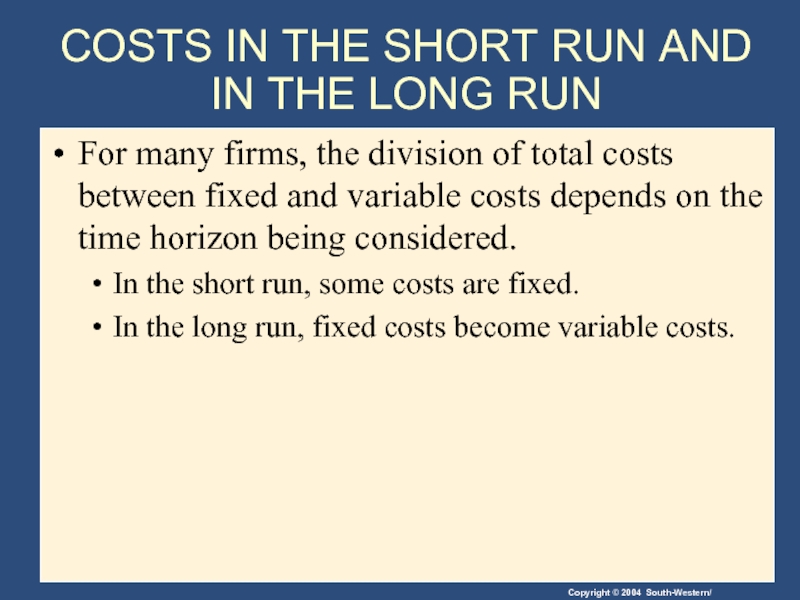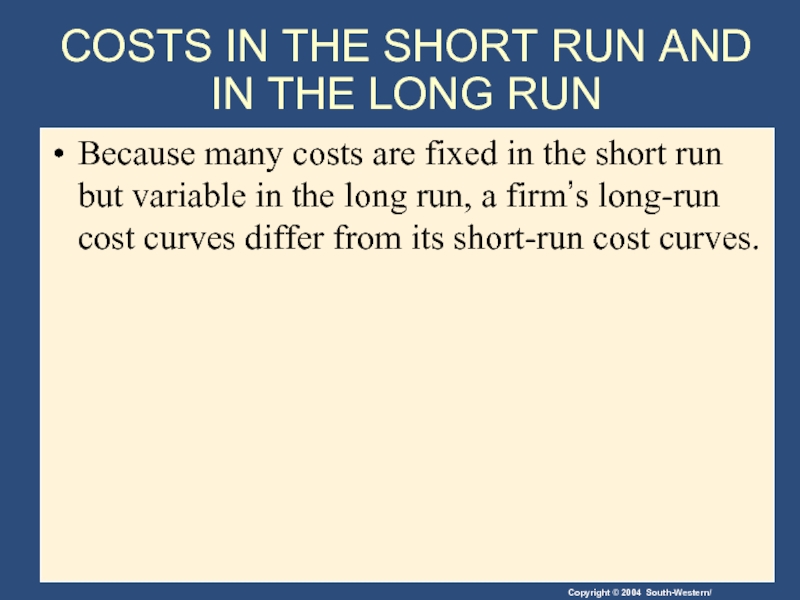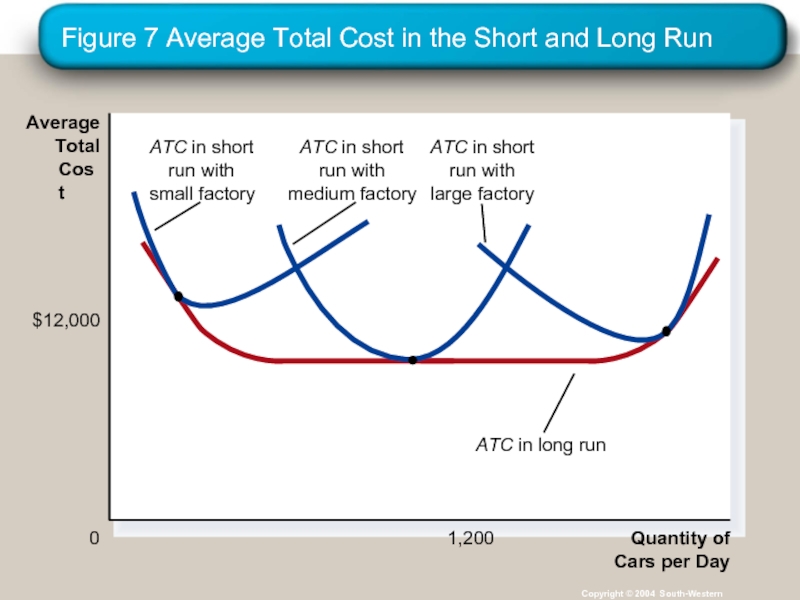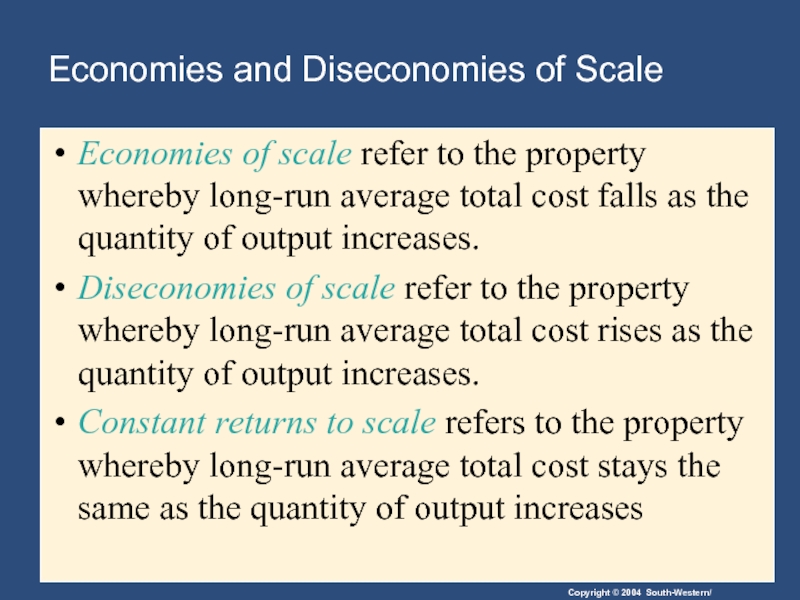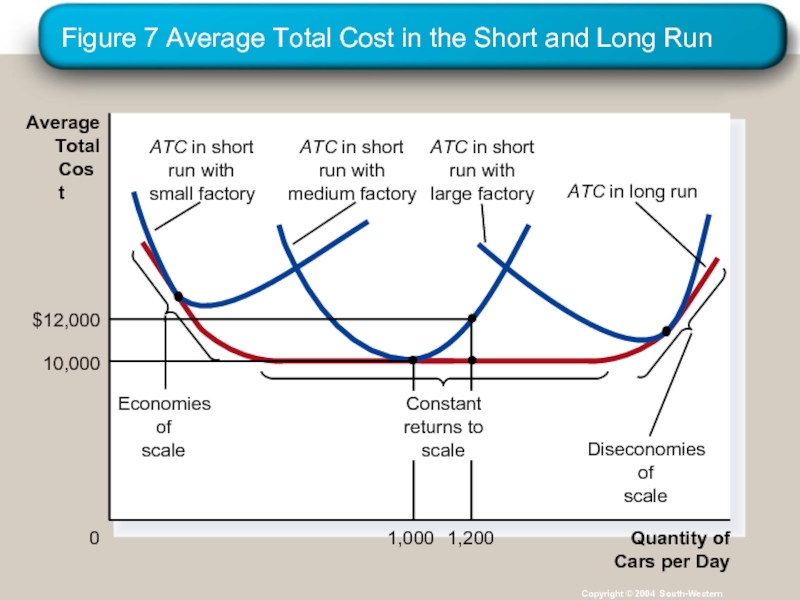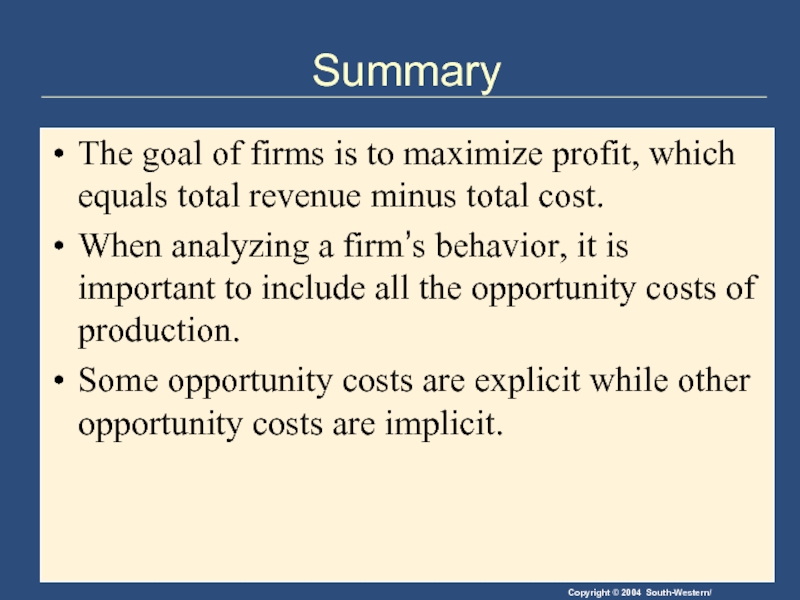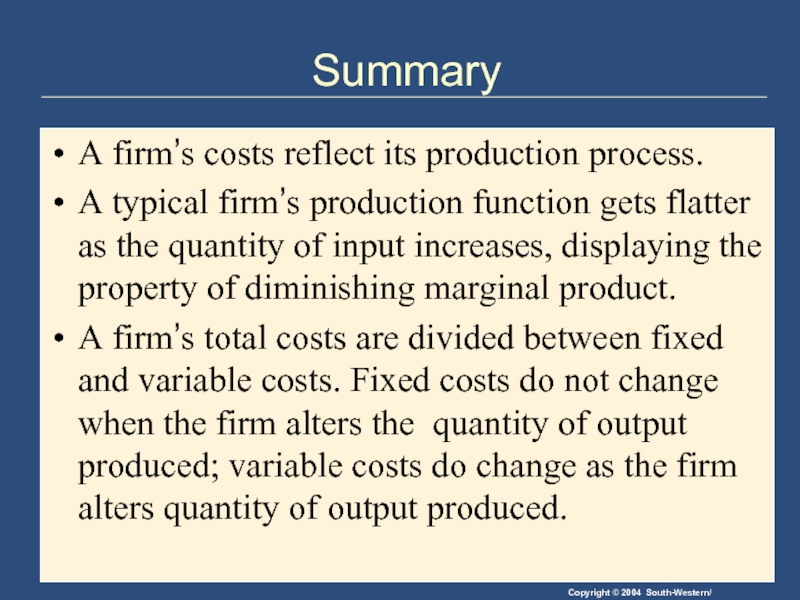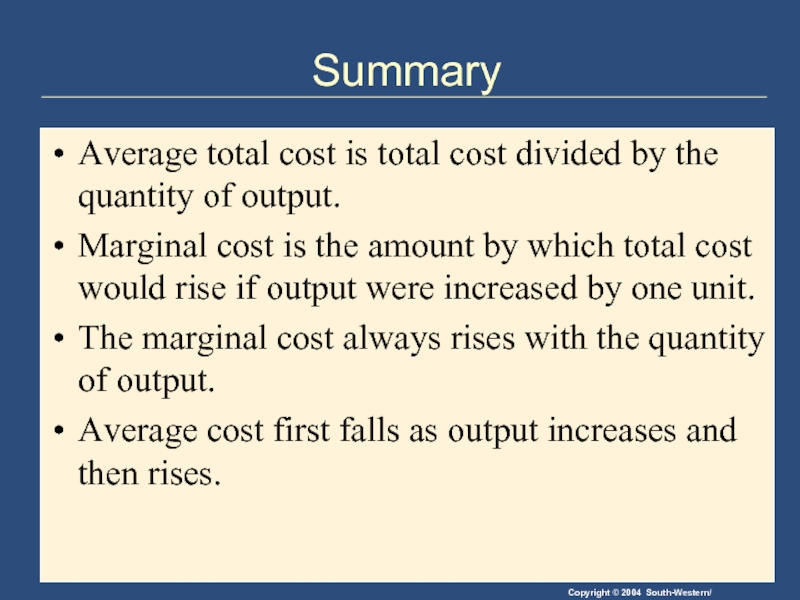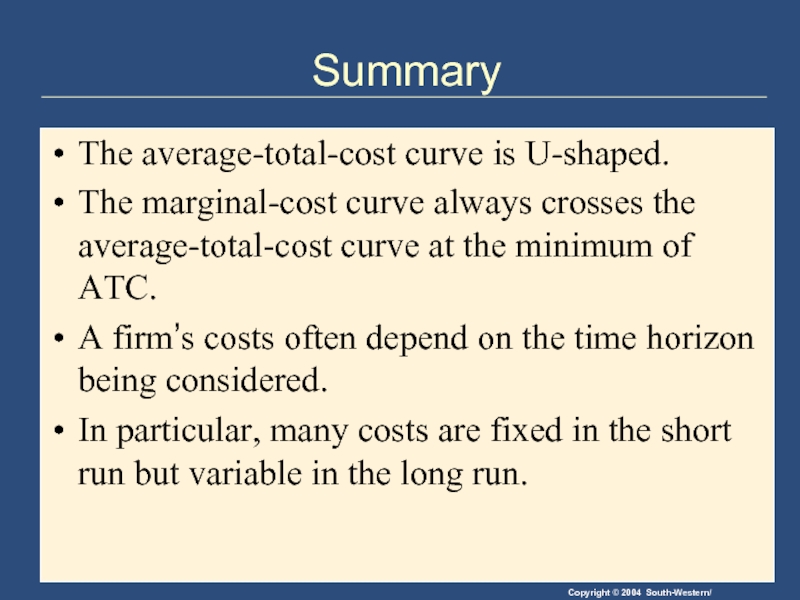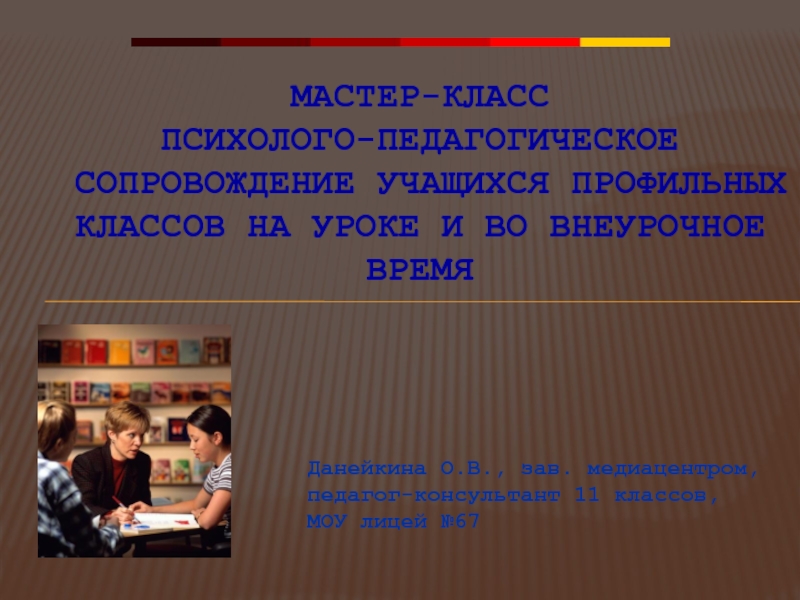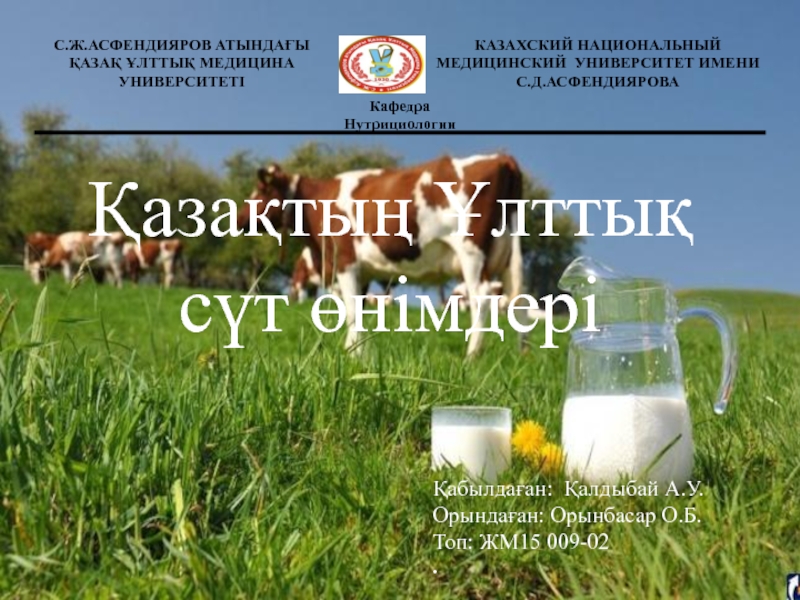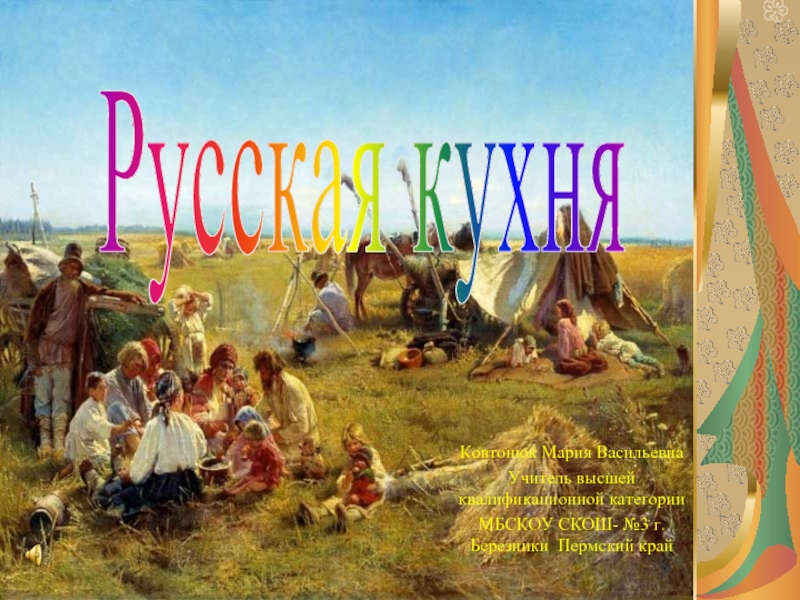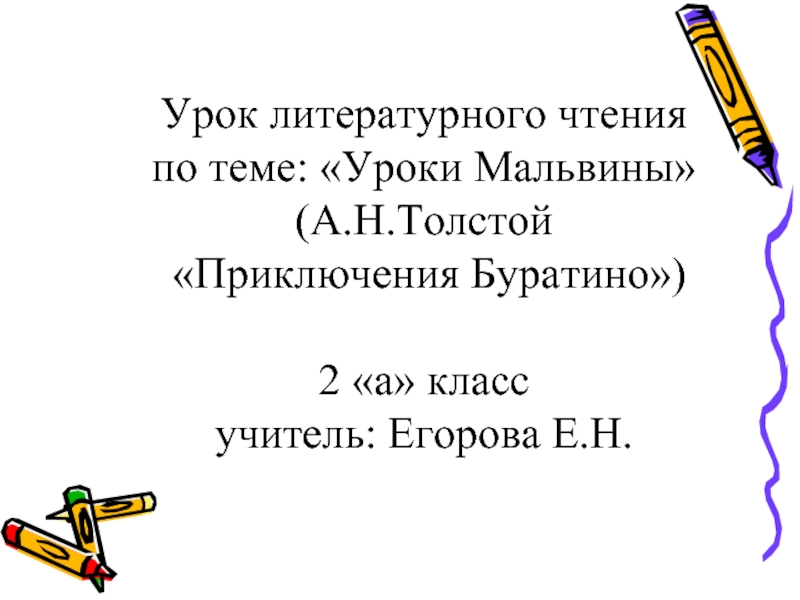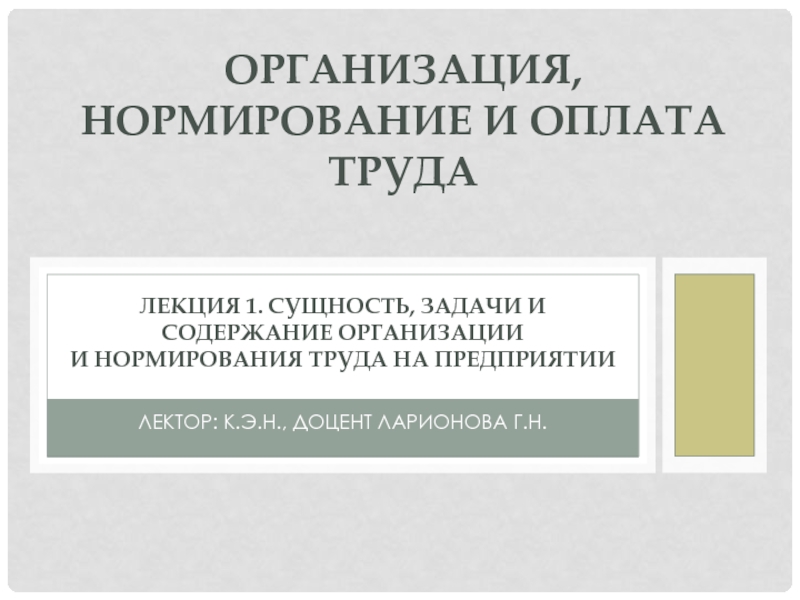- Главная
- Разное
- Дизайн
- Бизнес и предпринимательство
- Аналитика
- Образование
- Развлечения
- Красота и здоровье
- Финансы
- Государство
- Путешествия
- Спорт
- Недвижимость
- Армия
- Графика
- Культурология
- Еда и кулинария
- Лингвистика
- Английский язык
- Астрономия
- Алгебра
- Биология
- География
- Детские презентации
- Информатика
- История
- Литература
- Маркетинг
- Математика
- Медицина
- Менеджмент
- Музыка
- МХК
- Немецкий язык
- ОБЖ
- Обществознание
- Окружающий мир
- Педагогика
- Русский язык
- Технология
- Физика
- Философия
- Химия
- Шаблоны, картинки для презентаций
- Экология
- Экономика
- Юриспруденция
Firm behavior and the organization of industry. The costs of production презентация
Содержание
- 1. Firm behavior and the organization of industry. The costs of production
- 2. 13 The Costs of Production
- 3. The Market Forces of Supply and Demand
- 4. WHAT ARE COSTS? According to the Law
- 5. WHAT ARE COSTS? The Firm’s Objective The
- 6. Total Revenue, Total Cost, and Profit Total
- 7. Total Revenue, Total Cost, and Profit Profit
- 8. Costs as Opportunity Costs A firm’s cost
- 9. Economic Profit versus Accounting Profit Economists measure
- 10. Economic Profit versus Accounting Profit When total
- 11. Figure 1 Economic versus Accountants Copyright ©
- 12. Table 1 A Production Function and Total Cost: Hungry Helen’s Cookie Factory Copyright©2004 South-Western
- 13. PRODUCTION AND COSTS The Production Function The
- 14. The Production Function Marginal Product The
- 15. The Production Function Diminishing Marginal Product
- 16. Figure 2 Hungry Helen’s Production Function Copyright
- 17. The Production Function Diminishing Marginal Product
- 18. From the Production Function to the Total-Cost
- 19. Table 1 A Production Function and Total Cost: Hungry Helen’s Cookie Factory Copyright©2004 South-Western
- 20. Figure 3 Hungry Helen’s Total-Cost Curve Copyright
- 21. THE VARIOUS MEASURES OF COST Costs of
- 22. Fixed and Variable Costs Fixed costs are
- 23. Fixed and Variable Costs Total Costs Total
- 24. Table 2 The Various Measures of Cost: Thirsty Thelma’s Lemonade Stand Copyright©2004 South-Western
- 25. Fixed and Variable Costs Average Costs Average
- 26. Fixed and Variable Costs Average Costs Average
- 27. Average Costs
- 28. Table 2 The Various Measures of Cost: Thirsty Thelma’s Lemonade Stand Copyright©2004 South-Western
- 29. Fixed and Variable Costs Marginal Cost Marginal
- 30. Marginal Cost
- 31. Marginal Cost Thirsty Thelma’s Lemonade Stand
- 32. Figure 4 Thirsty Thelma’s Total-Cost Curves Copyright
- 33. Figure 5 Thirsty Thelma’s Average-Cost and Marginal-Cost
- 34. Cost Curves and Their Shapes Marginal cost
- 35. Figure 5 Thirsty Thelma’s Average-Cost and Marginal-Cost
- 36. Cost Curves and Their Shapes The average
- 37. Cost Curves and Their Shapes The bottom
- 38. Figure 5 Thirsty Thelma’s Average-Cost and Marginal-Cost
- 39. Cost Curves and Their Shapes Relationship
- 40. Cost Curves and Their Shapes Relationship
- 41. Figure 5 Thirsty Thelma’s Average-Cost and Marginal-Cost
- 42. Typical Cost Curves It is now time
- 43. Big Bob’s Cost Curves
- 44. Figure 6 Big Bob’s Cost Curves Copyright
- 45. Figure 6 Big Bob’s Cost Curves Copyright
- 46. Typical Cost Curves Three Important Properties
- 47. COSTS IN THE SHORT RUN AND IN
- 48. COSTS IN THE SHORT RUN AND IN
- 49. Figure 7 Average Total Cost in the
- 50. Economies and Diseconomies of Scale Economies of
- 51. Figure 7 Average Total Cost in the
- 52. Summary The goal of firms is to
- 53. Summary A firm’s costs reflect its production
- 54. Summary Average total cost is total cost
- 55. Summary The average-total-cost curve is U-shaped. The
Слайд 3The Market Forces of Supply and Demand
Supply and demand are the
Supply and demand are the forces that make market economies work.
Modern microeconomics is about supply, demand, and market equilibrium.
Слайд 4WHAT ARE COSTS?
According to the Law of Supply:
Firms are willing to
This results in a supply curve that slopes upward.
Слайд 5WHAT ARE COSTS?
The Firm’s Objective
The economic goal of the firm is
Maximum Profits
Слайд 6Total Revenue, Total Cost, and Profit
Total Revenue
The amount a firm receives
Total Cost
The market value of the inputs a firm uses in production.
Слайд 7Total Revenue, Total Cost, and Profit
Profit is the firm’s total revenue
Profit = Total revenue - Total cost
Слайд 8Costs as Opportunity Costs
A firm’s cost of production includes all the
Explicit and Implicit Costs
A firm’s cost of production include explicit costs and implicit costs.
Explicit costs are input costs that require a direct outlay of money by the firm.
Implicit costs are input costs that do not require an outlay of money by the firm.
Слайд 9Economic Profit versus Accounting Profit
Economists measure a firm’s economic profit as
Accountants measure the accounting profit as the firm’s total revenue minus only the firm’s explicit costs.
Слайд 10Economic Profit versus Accounting Profit
When total revenue exceeds both explicit and
Economic profit is smaller than accounting profit.
Слайд 11Figure 1 Economic versus Accountants
Copyright © 2004 South-Western
How an Economist
Views a
How an Accountant
Views a Firm
Слайд 12Table 1 A Production Function and Total Cost: Hungry Helen’s Cookie
Copyright©2004 South-Western
Слайд 13PRODUCTION AND COSTS
The Production Function
The production function shows the relationship between
Слайд 14The Production Function
Marginal Product
The marginal product of any input in
Слайд 15The Production Function
Diminishing Marginal Product
Diminishing marginal product is the property
Example: As more and more workers are hired at a firm, each additional worker contributes less and less to production because the firm has a limited amount of equipment.
Слайд 16Figure 2 Hungry Helen’s Production Function
Copyright © 2004 South-Western
Quantity of
Output
(cookies
per hour)
150
140
130
120
110
100
90
80
70
60
50
40
30
20
10
Number
0
1
2
3
4
5
Production function
Слайд 17The Production Function
Diminishing Marginal Product
The slope of the production
When the marginal product declines, the production function becomes flatter.
Слайд 18From the Production Function to the Total-Cost Curve
The relationship between the
The total-cost curve shows this relationship graphically.
Слайд 19Table 1 A Production Function and Total Cost: Hungry Helen’s Cookie
Copyright©2004 South-Western
Слайд 20Figure 3 Hungry Helen’s Total-Cost Curve
Copyright © 2004 South-Western
Total
Cost
$80
70
60
50
40
30
20
10
Quantity
of Output
(cookies per
0
10
20
30
150
130
110
90
70
50
40
140
120
100
80
60
Слайд 21THE VARIOUS MEASURES OF COST
Costs of production may be divided into
Слайд 22Fixed and Variable Costs
Fixed costs are those costs that do not
Variable costs are those costs that do vary with the quantity of output produced.
Слайд 23Fixed and Variable Costs
Total Costs
Total Fixed Costs (TFC)
Total Variable Costs (TVC)
Total
TC = TFC + TVC
Слайд 24Table 2 The Various Measures of Cost: Thirsty Thelma’s Lemonade Stand
Copyright©2004
Слайд 25Fixed and Variable Costs
Average Costs
Average costs can be determined by dividing
The average cost is the cost of each typical unit of product.
Слайд 26Fixed and Variable Costs
Average Costs
Average Fixed Costs (AFC)
Average Variable Costs (AVC)
Average
ATC = AFC + AVC
Слайд 28Table 2 The Various Measures of Cost: Thirsty Thelma’s Lemonade Stand
Copyright©2004
Слайд 29Fixed and Variable Costs
Marginal Cost
Marginal cost (MC) measures the increase in
Marginal cost helps answer the following question:
How much does it cost to produce an additional unit of output?
Слайд 32Figure 4 Thirsty Thelma’s Total-Cost Curves
Copyright © 2004 South-Western
Total Cost
$15.00
14.00
13.00
12.00
11.00
10.00
9.00
8.00
7.00
6.00
5.00
4.00
3.00
2.00
1.00
Quantity
of Output
(glasses
0
1
4
3
2
7
6
5
9
8
10
Total-cost curve
Слайд 33Figure 5 Thirsty Thelma’s Average-Cost and Marginal-Cost Curves
Copyright © 2004 South-Western
Costs
$3.50
3.25
3.00
2.75
2.50
2.25
2.00
1.75
1.50
1.25
1.00
0.75
0.50
0.25
Quantity
of
(glasses of lemonade per hour)
0
1
4
3
2
7
6
5
9
8
10
MC
ATC
AVC
AFC
Слайд 34Cost Curves and Their Shapes
Marginal cost rises with the amount of
This reflects the property of diminishing marginal product.
Слайд 35Figure 5 Thirsty Thelma’s Average-Cost and Marginal-Cost Curves
Copyright © 2004 South-Western
Costs
$3.50
3.25
3.00
2.75
2.50
2.25
2.00
1.75
1.50
1.25
1.00
0.75
0.50
0.25
Quantity
of
(glasses of lemonade per hour)
0
1
4
3
2
7
6
5
9
8
10
MC
Слайд 36Cost Curves and Their Shapes
The average total-cost curve is U-shaped.
At very
Average total cost declines as output increases.
Average total cost starts rising because average variable cost rises substantially.
Слайд 37Cost Curves and Their Shapes
The bottom of the U-shaped ATC curve
Слайд 38Figure 5 Thirsty Thelma’s Average-Cost and Marginal-Cost Curves
Copyright © 2004 South-Western
Costs
$3.50
3.25
3.00
2.75
2.50
2.25
2.00
1.75
1.50
1.25
1.00
0.75
0.50
0.25
Quantity
of
(glasses of lemonade per hour)
0
1
4
3
2
7
6
5
9
8
10
ATC
Слайд 39Cost Curves and Their Shapes
Relationship between Marginal Cost and Average
Whenever marginal cost is less than average total cost, average total cost is falling.
Whenever marginal cost is greater than average total cost, average total cost is rising.
Слайд 40Cost Curves and Their Shapes
Relationship Between Marginal Cost and Average
The marginal-cost curve crosses the average-total-cost curve at the efficient scale.
Efficient scale is the quantity that minimizes average total cost.
Слайд 41Figure 5 Thirsty Thelma’s Average-Cost and Marginal-Cost Curves
Copyright © 2004 South-Western
Costs
$3.50
3.25
3.00
2.75
2.50
2.25
2.00
1.75
1.50
1.25
1.00
0.75
0.50
0.25
Quantity
of
(glasses of lemonade per hour)
0
1
4
3
2
7
6
5
9
8
10
ATC
MC
Слайд 42Typical Cost Curves
It is now time to examine the relationships that
Слайд 44Figure 6 Big Bob’s Cost Curves
Copyright © 2004 South-Western
(a) Total-Cost Curve
$18.00
16.00
14.00
12.00
10.00
8.00
6.00
4.00
Quantity
TC
4
2
6
8
14
12
10
2.00
Total
Cost
0
Слайд 45Figure 6 Big Bob’s Cost Curves
Copyright © 2004 South-Western
(b) Marginal- and
Quantity of Output (bagels per hour)
Costs
$3.00
2.50
2.00
1.50
1.00
0.50
0
4
2
6
8
14
12
10
MC
ATC
AVC
AFC
Слайд 46Typical Cost Curves
Three Important Properties of Cost Curves
Marginal cost eventually
The average-total-cost curve is U-shaped.
The marginal-cost curve crosses the average-total-cost curve at the minimum of average total cost.
Слайд 47COSTS IN THE SHORT RUN AND IN THE LONG RUN
For many
In the short run, some costs are fixed.
In the long run, fixed costs become variable costs.
Слайд 48COSTS IN THE SHORT RUN AND IN THE LONG RUN
Because many
Слайд 49Figure 7 Average Total Cost in the Short and Long Run
Copyright
Quantity of
Cars per Day
0
Average
Total
Cost
1,200
$12,000
Слайд 50Economies and Diseconomies of Scale
Economies of scale refer to the property
Diseconomies of scale refer to the property whereby long-run average total cost rises as the quantity of output increases.
Constant returns to scale refers to the property whereby long-run average total cost stays the same as the quantity of output increases
Слайд 51Figure 7 Average Total Cost in the Short and Long Run
Copyright
Quantity of
Cars per Day
0
Average
Total
Cost
Слайд 52Summary
The goal of firms is to maximize profit, which equals total
When analyzing a firm’s behavior, it is important to include all the opportunity costs of production.
Some opportunity costs are explicit while other opportunity costs are implicit.
Слайд 53Summary
A firm’s costs reflect its production process.
A typical firm’s production function
A firm’s total costs are divided between fixed and variable costs. Fixed costs do not change when the firm alters the quantity of output produced; variable costs do change as the firm alters quantity of output produced.
Слайд 54Summary
Average total cost is total cost divided by the quantity of
Marginal cost is the amount by which total cost would rise if output were increased by one unit.
The marginal cost always rises with the quantity of output.
Average cost first falls as output increases and then rises.
Слайд 55Summary
The average-total-cost curve is U-shaped.
The marginal-cost curve always crosses the average-total-cost
A firm’s costs often depend on the time horizon being considered.
In particular, many costs are fixed in the short run but variable in the long run.
